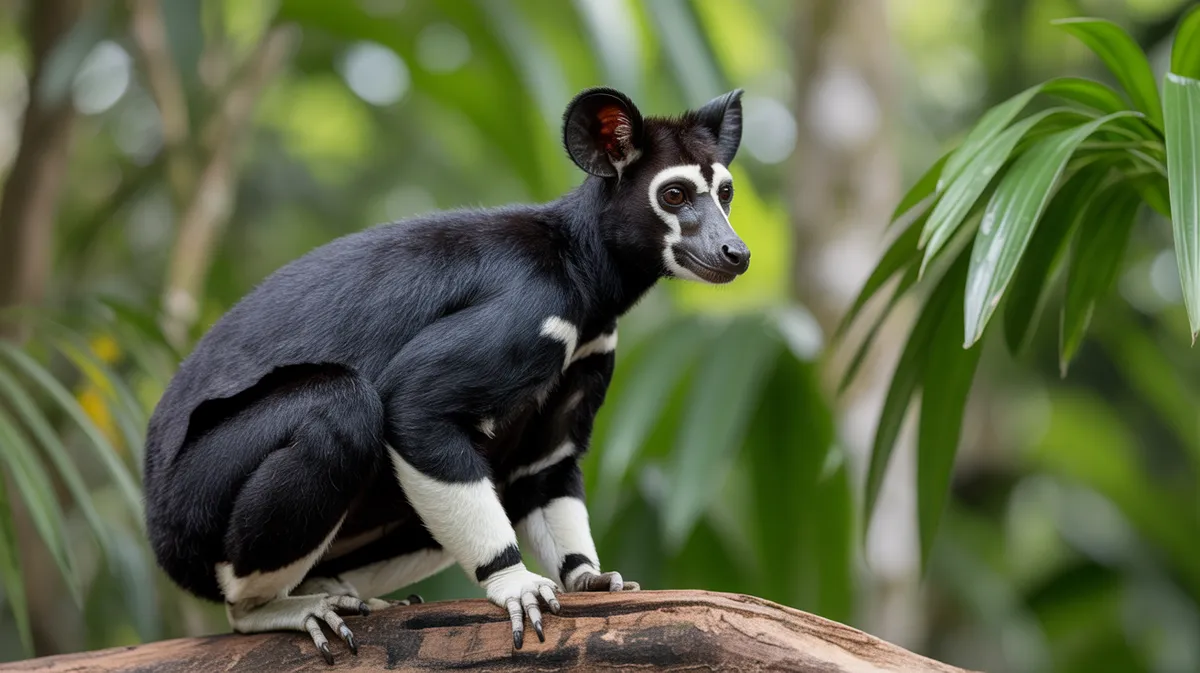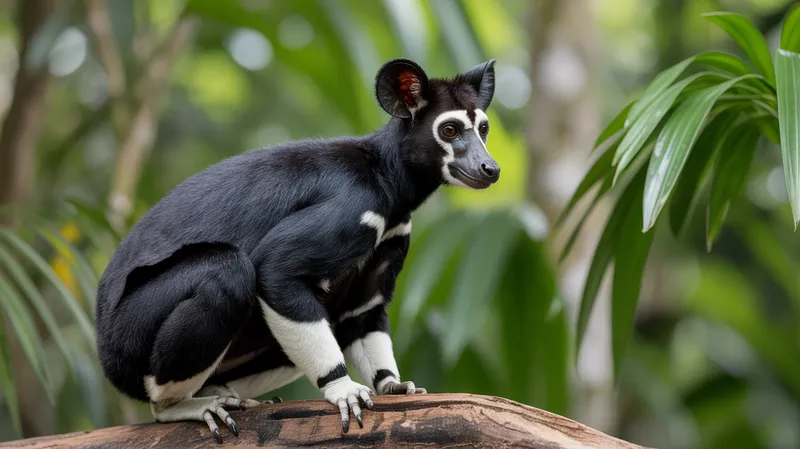
Indri
Indri indri

Meet the Indri
The Indri is the largest living lemur, native exclusively to the eastern rainforests of Madagascar. It is known for its striking black-and-white coloration, long limbs, and lack of a visible tail. Indris are famous for their loud, eerie calls that echo through the forest, serving both to mark territory and communicate with other groups. These highly social primates live in small family groups and are strictly arboreal, rarely descending to the ground. Indris play an important ecological role as seed dispersers within their forest habitat.
Classification
Mammal
Habitat
Tropical rainforest
Diet
Herbivore
Lifespan
15-18 years in the wild
Conservation
Critically Endangered
Weight
6-9.5 kg
📖Fascinating Facts
Tree Dwellers
Indris are strictly arboreal and spend nearly their entire lives in the upper canopy of Madagascar’s rainforests.
Unique Calls
Their powerful, song-like calls serve to define territories and maintain social contact across long distances.
No Tail
The Indri is unique among lemurs for its near-total lack of a tail, giving it a distinctive appearance.
📋Detailed Description
The Indri (Indri indri) is the largest extant lemur, with adults typically measuring 64–72 cm in head-body length and weighing between 6 and 9.5 kg. Its dense, woolly fur is strikingly patterned in black and white, with considerable individual variation in the extent and placement of these colors. The species is tailless, a unique trait among lemurs, and possesses long, powerful hind limbs adapted for vertical clinging and leaping—enabling it to traverse gaps of up to 10 meters between trees. Indris have a rounded face with a short muzzle, large forward-facing eyes for stereoscopic vision, and prominent, rounded ears. Their hands and feet are highly dexterous, with opposable thumbs and big toes aiding in grasping branches. Indris are strictly diurnal and arboreal, rarely descending to the forest floor. They are renowned for their complex, far-carrying vocalizations, which serve both territorial and social functions. Socially, Indris live in small, cohesive family groups, typically consisting of a monogamous pair and their offspring. Their diet is primarily folivorous, but they also consume seeds, flowers, and fruit, with dietary composition varying seasonally. Indris play a crucial ecological role as seed dispersers and are considered a keystone species within Madagascar’s eastern rainforests.
💡 Did you know?
The Indri cannot survive in captivity and has never been successfully kept in any zoo or wildlife park worldwide.
🔬Research & Sources
Wikipedia Summary
The indri, also called the babakoto, is one of the largest living lemurs, with a head-body length of about 64–72 cm and a weight of between 6 and 9.5 kg. It has a black and white coat and maintains an upright posture when climbing or clinging. It is monogamous and lives in small family groups, moving through the canopy, and is herbivorous, feeding mainly on leaves but also seeds, fruits, and flowers. The groups are quite vocal, communicating with other groups by singing, roaring and other vocalisations. Besides humans, it is the only mammal found that can use rhythm.
Last Modified: 6/2/2025
🎭Behavior & Social Structure
Indris are highly social primates, forming stable family groups of two to six individuals, usually comprising a mated pair and their juvenile offspring. They maintain strong pair bonds, engaging in mutual grooming and coordinated activities. Indris are territorial, with home ranges averaging 18–40 hectares, which they defend through loud, coordinated vocal displays known as 'songs.' These vocalizations, which can last up to three minutes and be heard over 2 km away, are used to delineate territory and reinforce group cohesion. Indris are exclusively arboreal and move through the canopy using vertical clinging and leaping, launching themselves between trunks and branches with powerful hind limbs. Their daily activity begins at dawn, with most foraging and movement occurring in the morning and late afternoon. Feeding is a slow, deliberate process, with individuals selecting young leaves, flowers, and fruit, and spending long periods resting and digesting their fibrous diet. Social interactions are frequent and include play among juveniles, grooming, and synchronized resting.
👶Reproduction & Life Cycle
Indris are among the few primates exhibiting social monogamy, with pairs typically remaining together for life. The breeding season occurs between December and March, coinciding with the rainy season when food is most abundant. Females are receptive for only a few days each year, and successful mating is closely tied to this brief window. After a gestation period of approximately 120–150 days, a single offspring is born, usually between May and June. Infants are altricial and initially cling to the mother’s belly, later transferring to her back as they grow. Weaning occurs at 7–8 months, but juveniles remain dependent on their parents for up to two years. Females reach sexual maturity at around 7–9 years, while males mature slightly earlier. Reproductive rates are low, with females typically giving birth only once every two to three years, contributing to the species’ vulnerability.
🛡️Adaptations & Survival
The Indri exhibits several adaptations to its arboreal, folivorous lifestyle. Its powerful hind limbs and flexible hip joints enable extraordinary leaping ability, crucial for navigating the discontinuous canopy of Madagascar’s rainforests. The absence of a tail is compensated by a robust, upright posture and strong core musculature, aiding balance during vertical clinging and leaping. Indris possess a specialized dentition, including a toothcomb formed by the lower incisors and canines, used for grooming and processing leaves. Their large cecum and elongated colon facilitate the fermentation and digestion of fibrous plant material. Behaviorally, their complex vocalizations are an adaptation for long-distance communication in dense forest, and their monogamous social structure may be a response to the patchy distribution of suitable food resources. Seasonal dietary flexibility allows them to exploit a range of plant species as availability changes.
📚Research Sources
🎨Cultural Significance
The Indri holds profound significance in Malagasy culture, particularly among the Betsimisaraka and other eastern Malagasy peoples. Locally known as 'babakoto,' the Indri is often regarded as a sacred animal, believed to be the ancestor of humans or a reincarnated human spirit. Numerous taboos (fady) protect the Indri from hunting in certain regions, and its haunting calls are woven into local folklore. The species features in origin myths and is sometimes associated with omens or spiritual messages. Despite these protections, changing cultural attitudes and economic pressures have led to increased hunting in some areas.
🔬Recent Research & Discoveries
Recent research has highlighted the Indri’s unique vocal abilities, including the use of rhythm and pitch patterns previously thought to be exclusive to humans. A 2021 study demonstrated that Indri songs exhibit categorical rhythm, making them the only non-human mammal known to produce such rhythmic patterns. Ongoing genetic studies are investigating population structure and gene flow among fragmented habitats, providing insights for conservation planning. Ecological research continues to document the Indri’s role in seed dispersal and forest regeneration. Long-term field studies in reserves such as Analamazaotra and Mantadia are monitoring population trends, reproductive success, and the impact of habitat disturbance.
🎥Wildlife Videos

Cute Jumping Indri Lemurs | Madagascar | BBC Earth
Lemurs are native only to Madagascar, and the indri is the biggest of them all. Narrated by Sir David Attenborough. Subscribe to ...
BBC Earth

Indris: Largest Species of Lemur in the World 🤩 Madagascar: Africa's Galapagos | Smithsonian Channel
Indris are the largest of Madagascar's lemurs, and also one of the more adept at arboreal living. Using their long legs, they are ...
Smithsonian Channel

SECRETS OF MADAGASCAR | Survival Journey in Nature’s Isolated Paradise | Animal documentary
SECRETS OF MADAGASCAR | Survival Journey in Nature's Isolated Paradise Welcome to Madagascar – the isolated ...
WILD NATURE - Nature animal documentary

Madagascar - Wildlife and Green Treasures of the Red Island
Madagascar, is the World's 5th biggest island and shelters a unique fauna, endangered for most part. This film offers unique ...
wocomoWILDLIFE

Echoes of the Forest: The Melodic World of the Indri Lemur
Join us on an enchanting journey through the lush forests of Madagascar as we explore the captivating world of the Indri Lemur.
WildPaws Planet

Indris’ Fight for Survival in Madagascar’s Rainforest | Land of Gremlins Ep101
This is the story of a day in the life of an Indris Family following a mother, father, and their three offspring around their home in the ...
Love Nature
🌍Habitat Information
The Indri typically inhabits Tropical rainforest environments. Indris have adapted to their environments with specialized features and behaviors.
Primary Habitat:
Tropical rainforest
More detailed habitat information will be available soon.
🛡️Conservation Status
The Indri is currently classified as Critically Endangered. Conservation efforts are crucial for preserving this species for future generations.
Common Threats:
- 🏠Habitat loss and fragmentation
- 🌡️Climate change impacts
- 🎯Hunting and poaching
- 🏭Human-wildlife conflict
⚠️Threats & Conservation Challenges
The Indri is classified as Critically Endangered by the IUCN, with population estimates suggesting fewer than 10,000 mature individuals remain. The species faces severe threats from habitat loss due to slash-and-burn agriculture (tavy), illegal logging, and charcoal production, which fragment and degrade its rainforest habitat. Hunting, although culturally taboo in some regions, occurs in others, particularly as traditional beliefs erode. Indris are highly sensitive to habitat disturbance and have limited capacity to adapt to secondary or degraded forests. Their low reproductive rate further exacerbates population declines. Conservation efforts are hampered by ongoing political instability in Madagascar, limited enforcement of protected areas, and the species’ poor survival in captivity—no Indri has ever been successfully bred or maintained long-term outside its natural habitat.
🔬Scientific Classification
Scientific Name
Indri indri
Classification Hierarchy
🔍 About Taxonomic Classification
Taxonomic classification is a hierarchical system used by scientists to classify and organize living organisms based on shared characteristics and evolutionary relationships.
The system moves from broad categories (Kingdom) to increasingly specific ones, with each animal's scientific name typically consisting of its Genus and species.
📝Community Notes
Share your observations and insights about the Indri with our community of wildlife enthusiasts.
Join Our Community
Sign in to share your observations and connect with fellow wildlife enthusiasts.
Sign In to ContributeNo community notes yet
Be the first to share your observations about the Indri!
Explore Indri
Select a tab above to learn more about this amazing animal.
📸Photo Gallery
No photos available for this animal yet.
🌟Discover More Wildlife
Continue your journey of discovery with more fascinating animals from our database
